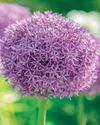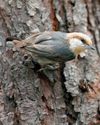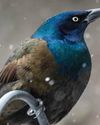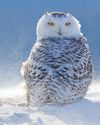
Caw, caw! Jaaay, jaaay! Even if you're not sure what a corvid is, you've almost certainly heard one. Birds in the Corvidae family aren't bashful.
They're loud and proud, and they have the brains to back up their confidence. Seventeen corvid species call North America home, most of them being jays, crows or ravens.
At least one corvid species is present in nearly every corner of the U.S., using its hefty brain power to trick unsuspecting humans, play pranks on other birds and even to hold funerals for fallen flock members.
"A lot of field observations and lab work show their ability to solve various problems and remember past events for long periods of time," says John Marzluff, professor of wildlife science at the University of Washington. Here's what you should know about these super-smart birds.
JAYS
Inquisitive and boisterous, jays are a staple in many North American yards. Birders may spot blue jays, Steller's jays or one of the three most common types of scrub-jays: Woodhouse's, California or Florida. The jays call a wide variety of habitats home, from evergreen forests to suburban yards and shrublands, and are known for their loud and varying vocalizations.
John, who has studied corvids for 40 years, explains that blue jays' food-storing behaviors help disperse oak acorns. "That relationship is maybe one of the reasons oaks and bird-dispersed plants produce so much seed," he says. "Some of it gets eaten, but some of it doesn't. It's like having a little farmer work for you."
Besides their ability to spread seeds, jays are known for being mischievous. California scrub-jays, for example, steal acorns from acorn woodpecker caches and from other scrub-jays. Steller's and Canada jays will swoop in to snatch food from unsuspecting campers, and blue jays imitate the calls of red-shouldered hawks to trick other birds into thinking a predator is near.
This story is from the February/March 2023 edition of Birds & Blooms.
Start your 7-day Magzter GOLD free trial to access thousands of curated premium stories, and 9,000+ magazines and newspapers.
Already a subscriber ? Sign In
This story is from the February/March 2023 edition of Birds & Blooms.
Start your 7-day Magzter GOLD free trial to access thousands of curated premium stories, and 9,000+ magazines and newspapers.
Already a subscriber? Sign In

Basics of Hydroponics
Use these top tips and plant picks to have a successful soil-free garden

Rooted in Resilience
These hardy perennials will thrive in most zones

Social and Supportive
Brown-headed nuthatches take a helpful approach to raising their young

All About Owl Pellets
And why you should give a hoot about them

Ask the Experts
Advice from our pros about houseplants, bird feeding and more

BRING THE OUTDOORS IN
Making a terrarium is about as close as you can get to a Zen DIY project. Once you have gathered the proper materials and squared away your plant selections, it's as simple as layering it all together and watching your mini ecosystem thrive. Here, I'll walk you through my foolproof process and cover all the required elements for good filtration, healthy soil, strong root growth and resistance against fungus and disease.

GROW THIS. NOT THAT
Six easy-to-grow houseplants—and six that may not be the right choice for you

Winter MAGIC
Forecasts may be frigid, but grab your binoculars because birding opportunities are still incredible

Sense or Nonsense? - Why some birds can taste and smell - but others can't
Does a porcelain berry taste like a blueberry to a gray catbird? Does a block of lard smell like frying bacon to a northern flicker? The short answer is no. While some avian species do have a well-adapted sense of taste or smell, they can't distinguish between flavors and odors the way humans can. They're not picking up every ingredient in the suet you put out, says José Ramírez-Garofalo, an ornithology researcher at Rutgers University in New Jersey and the director of Freshkills Biological Station in Staten Island, New York.

Maple Mania - Amazing facts about this fall foliage mainstay
Amazing facts about this fall foliage mainstay